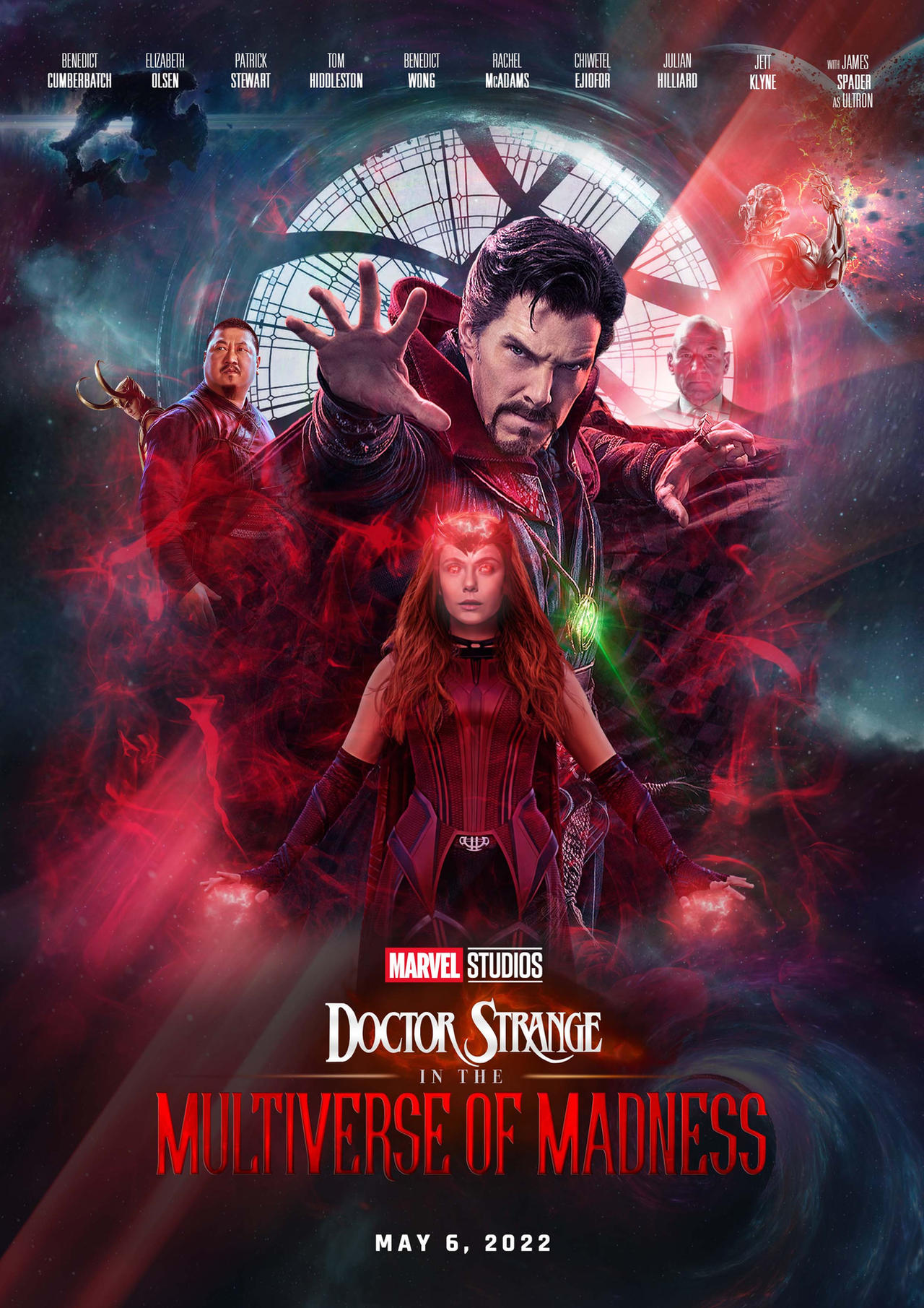
16 May Nerdy for Thirty #16: Doctor Strange in the Multiverse of Madness
DOCTOR STRANGE IN THE MULTIVERSE OF MADNESS
dir. Sam Raimi, starring Benedict Cumberbatch, Elizabeth Olsen, Xochitl Gomez, Benedict Wong, et al
Doctor Strange in the Multiverse of Madness, the sequel to 2016’s Doctor Strange, continues to delve into the mystical side of the Marvel Cinematic Universe as our favorite wizards battle a number of multiversal threats willing to destroy it all to achieve their goals. Doctor Stephen Strange, former Sorcerer Supreme, is forced to deal with threats both old and new as he traverses universes to protect America Chavez, a young woman born with the ability to naturally hop through universes as she’s being hunted. With assistance from trusty ally Wong, Strange appeals to former Avenger Wanda Maximoff for help in fending off this new threat to reality.
Multiverse of Madness is what happens when a filmmaker is presented with the option of delivering massive dopamine hits to their willing audience or telling a layered story that decides to progress the characters instead of the overall narrative of the MCU. Luckily, writer Michael Waldron (also responsibly for the Loki show on Disney+), director Sam Raimi, and cinematographer John Mathieson choose to tackle the latter, deepening the relationship between Strange and Christine Palmer, further exploring Wanda’s pain and desires, and introducing Xochitl Gomez as America Chavez. In what has become a now famous MCU move of not fully adapting the source material from which some of the films draw their inspiration, Raimi and company manage to match the tone of 2005’s House of M storyline without ever actually cribbing from it. Themes of learning to trust, facing past regrets, and wants vs needs are fully explored throughout the movie. While some fans have been primed for cameos galore, Raimi keeps the story in check, keeping the cameos to a small handful that are still sure to delight and stoke the endless fires of speculation. In the same vein that Captain America: Civil War was a star-studded event that still strongly focused on its titular character, the same can be said for Doctor Strange in the Multiverse of Madness: regardless of who shows up, Doctor Strange is front and center, appearing in almost every frame of the movie. Raimi and Waldron never lose sight of the fact that this is Stephen Strange’s film, a fact that, in the hands of less talented filmmakers (or filmmakers less willing to stick to their guns), might’ve been their doom. Raimi’s horror sensibilities are on full display, setting the grimmest tone seen in an MCU movie yet. While not full-on horror (it’s Disney after all), Raimi manages to push that envelope as far as he possibly can while adhering to the universe set up before his arrival. The end result is a bleak, relentless movie that still manages to deliver on the fun adventure and surprises that MCU fans have come to expect.
Benedict Cumberbatch, returning to the MCU for his sixth appearance, proves yet again why he was the perfect casting for the character of Doctor Strange. Cumberbatch’s ability to play intelligent, arrogant men is put on full display at the beginning of the film, giving audiences the most accurate representation of the character yet. At this point fully comfortable in the role, Cumberbatch plays the good doctor this time out with an ounce of melancholy tinged at the edges of his performance. Where Cumberbatch leaves the character in the movie’s closing moments as compared to its opening proves Strange has gone on a massive journey, both physically and figuratively. Shaping up to be one of the backbones of the MCU, Cumberbatch’s steady, dependable performance will be a delight to see for years to come.
I say all that to say Elizabeth Olsen puts Cumberbatch to shame in almost every frame of the movie. Stealing scene after scene, Olsen has never been better as Wanda Maximoff than she is in Multiverse of Madness. An impetus for the events of the film, Olsen’s Wanda is a woman with a one track mind: getting back to her kids first seen WandaVision. It’s Wanda’s sole drive in the movie and Olsen leans fully into peeling back every layer of the character. While playing multiple versions of herself, Olsen gets to display a range of emotions from bitter disgust to outright despair. Even when not on screen, Wanda’s presence is felt, easily making her the standout character of the entire movie.
Unfortunately, not every character gets a chance to shine like Wanda does. Mainly, the disservice falls to Xochitl Gomez as America Chavez, member of the Young Avengers. While the MCU has been quietly introducing all the members in the background of other movies, America is a key character of Multiverse of Madness. It’s this fact that makes the viewing frustrating to realize how little development the character gets, outside of a minute or two of backstory. As the film’s overall Living McGuffin, America is hunted and pursued by any numbers of creatures, and while it’s Stephen Strange’s mission to keep her safe, the story does scant little to give us a reason to care about her. While Xochitl does a good job with the material she’s given, there’s times where she disappears from the film completely, sacrificed either in editing or in the writing stages to give more time for developing other relationships. Possibly the film’s biggest disappointment, Xochitl’s presence is a delight when she’s on screen and absence noticed when she’s not. Disney did somehow less than the bare minimum in regard to America’s orientation; a character in the comics that’s unabashedly, proudly lesbian gets little more than a mention of having two mothers and an LGBTQ pin on her infamous denim jacket. There’s plenty more left to be mined with America, and hopefully Xochitl gets the screen time she deserves going forward.
Returning for larger roles than anticipated are Rachel McAdams as nurse Christine Palmer and Benedict Wong, the current Sorcerer Supreme. The relationship between Palmer and Strange is the heart of the film, kicked off by a seemingly simple question that becomes one of the motifs throughout. While the MCU has had a varying amount of success when it comes to portraying relationships, Strange and Palmer’s is certainly one of the more interesting ones. Playing off decisions made during the 2016 Doctor Strange, viewers meet Palmer as she’s getting married, with Stephen in the audience. An interplay between them somewhat reminiscent of the exchange between Tony and Pepper at the bar in the first Iron Man but with a more somber tone, it’s clear that Strange and Palmer’s relationship on screen is one of the MCU’s most complex. Benedict Wong, slimmed down and looking better than ever, is a delight as Wong, Strange’s right hand man and staunchest ally. With an increased role due to his responsibilities as the Sorcerer Supreme, Wong is allotted more screen time and more to do with that screen time. In a few scant appearances since his debut in the first movie, Wong’s glowup from sanctum librarian to head wizard has been a joy to experience and the bond between him and Strange make for some of the highlights of the movie.
Almost 20 years to the exact date of the release of his first superhero movie, director Sam Raimi returns to the big budget blockbuster world of capes and tights to deliver a movie that only he could make. Featuring all the familiar camera angles, shot compositions, and tonal uneasiness we’ve come to expect from him, Multiverse of Madness is just as much a Raimi film as it is an MCU movie. While it’s unfortunate previous director Scott Derrickson exited the project due to creative differences, the end result should make the audience appreciate living in the universe where this film exists. Drawing from his previous works that are signature Raimi style, the veteran director (not seen since 2013’s Oz the Great and Powerful) managed to create a tone and feel far more sinister than anything imagined within the MCU thus far. What we get are the classic elements of horror: jump scares, unyielding dreadful tension, and outrageously vivid creature work. Kicking the film off by dropping the audience into the middle of an action scene and keeping his foot on the pedal, Raimi’s first and third acts are amongst some of the best in the MCU. Unfortunately, the second act slows the story down drastically once the multiverse is fully established. Handling Strange’s story, his relationship with Christine Palmer, Wanda’s story, and the introduction of America Chavez and the multiverse is a tall order with a lot of moving parts, and those parts don’t always rub up against each other in ways that flow naturally. Raimi makes up for these incongruent pieces with some top notch action scenes that give the characters the opportunities to display a full array of their power sets. For everything that doesn’t work in the movie (namely, the second act slog and the handling of America Chavez), Raimi manages to provide enough good to counterbalance that.
Cinematographer John Mathieson returns to the world of superheroes for the first time since 2017’s Logan, creating a look that couldn’t be more opposite. Bright, colorful, and brimming with flare, Mathieson follows previous Dr. Strange DP Ben Davis, managing to match styles while also putting his own unique stamp on the franchise. The music does its best to keep up with the visuals; while it was disappointing to hear of white-hot composer Michael Giacchino’s exit from the movie after director Scott Derrickson’s departure, Raimi’s decision to bring on Age of Ultron composer Danny Elfman proves to be the right choice. Elfman’s notes compliment Mathieson’s visuals wonderfully, especially in a surprisingly unique battle between Doctor Stranges that plays more as Close Encounters of the Third Kind than it does a contest of wills.
Overall, Doctor Strange in the Multiverse of Madness proves that, in most cases, it’s best to just let the creatives create. Sam Raimi manages to walk the tightrope balancing MCU storytelling with his unique style, blending them to create an experience that is both familiar to diehards while simultaneously being wholly refreshing. Far darker in tone than any previous film to date, the magical realm of the MCU continues to be developed and fleshed out in creative and entertaining ways. While still firmly Benedict Cumberbatch’s movie, Elizabeth Olsen dominates every scene she’s in, delivering a captivating and heart wrenching performance that will forever cement her in the annals of great MCU actors. At just a hair over two hours, the movie starts at a breakneck pace and ends in a similar fashion while possibly leaving more questions than it answers. An absolute must-see in the IMAX format if possible, the movie is a jaw dropping spectacle filled with great characters moments, small nuggets of contained surprises, and dynamic set pieces.
Review by Darryl Mansel


No Comments